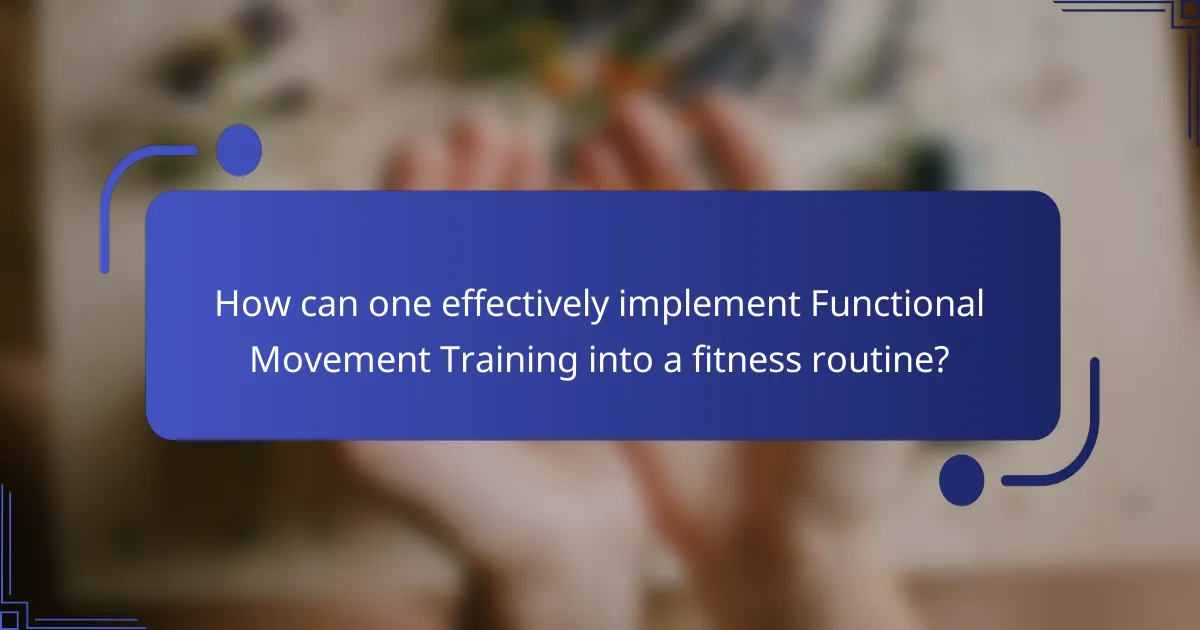Functional Movement Training enhances mobility, strength, and balance for optimal health. This approach focuses on multi-joint movements, injury prevention, and improved physical performance. Implementing tailored exercises can address individual needs and capabilities. Regular assessments ensure effective progress and adaptation for diverse populations.

What are the fundamental principles of Functional Movement Training?
Functional Movement Training emphasizes movement patterns that enhance daily activities and overall health. Key principles include multi-joint movements, balance, and strength training. These principles promote functional strength, flexibility, and coordination. Implementing them can lead to improved physical performance and injury prevention.
How does Functional Movement Training differ from traditional exercise methods?
Functional Movement Training focuses on real-life movements, while traditional exercise methods often isolate muscle groups. Functional training enhances overall body coordination and stability, promoting injury prevention and improved daily performance. Traditional methods may neglect these aspects, emphasizing strength or endurance without functional application. This approach fosters adaptability, making it suitable for diverse activities and enhancing quality of life.
Why is body awareness crucial in Functional Movement Training?
Body awareness is crucial in Functional Movement Training because it enhances coordination and prevents injuries. Understanding body positioning and movement patterns allows individuals to execute exercises effectively. This awareness leads to improved functional performance and overall health outcomes. Additionally, it fosters a deeper connection between mind and body, promoting better engagement during training sessions. As a result, individuals can achieve their fitness goals more efficiently and safely.

What are the key benefits of Functional Movement Training for overall health?
Functional Movement Training enhances overall health by improving mobility, strength, and balance. It promotes functional fitness, which translates to better performance in daily activities. Key benefits include injury prevention, enhanced athletic performance, and improved posture. Additionally, it fosters better body awareness and coordination, contributing to overall well-being.
How can Functional Movement Training enhance athletic performance?
Functional Movement Training enhances athletic performance by improving strength, flexibility, and coordination. This training focuses on movements that mimic daily activities, leading to better functional capacity. Enhanced neuromuscular efficiency results in improved reaction times and injury prevention. Athletes often experience increased power output and endurance, which translates to superior performance in their respective sports.
Which health conditions can be improved through Functional Movement Training?
Functional Movement Training can improve various health conditions including chronic pain, mobility issues, and athletic performance. This training focuses on enhancing movement patterns to prevent injuries and promote overall well-being. Research indicates that it benefits individuals with arthritis, back pain, and postural imbalances by increasing strength and flexibility. Additionally, it aids in rehabilitation from injuries by restoring functional movement and enhancing recovery.

How can one effectively implement Functional Movement Training into a fitness routine?
To effectively implement Functional Movement Training into a fitness routine, start by assessing individual movement patterns. Focus on exercises that mimic daily activities, enhancing strength, flexibility, and coordination. Gradually increase complexity and intensity, ensuring proper form to prevent injury. Incorporate mobility work and functional drills consistently for optimal results.
What are the best practices for starting Functional Movement Training?
To start Functional Movement Training effectively, focus on assessing movement patterns, setting clear goals, and using progressive exercises. Begin with a movement screening to identify limitations. Establish specific, measurable objectives tailored to individual needs. Incorporate exercises that mimic daily activities, emphasizing core stability and joint mobility. Consistently monitor progress to adjust the training plan as necessary.
Which tools and equipment are recommended for Functional Movement Training?
Functional Movement Training utilizes various tools and equipment to enhance performance and prevent injuries. Recommended tools include resistance bands, stability balls, kettlebells, foam rollers, and balance boards. These tools support core strength, flexibility, and coordination, essential for functional movement patterns.

What role does assessment play in Functional Movement Training?
Assessment plays a crucial role in Functional Movement Training by identifying movement deficiencies and guiding personalized interventions. It helps practitioners develop tailored programs that enhance functional performance and prevent injuries. Regular assessments track progress and inform necessary adjustments to training regimens. This ongoing evaluation ensures that training effectively meets individual health goals, maximizing the benefits of functional movement exercises.
How can movement assessments optimize training outcomes?
Movement assessments optimize training outcomes by identifying individual strengths and weaknesses. This tailored approach enhances performance and reduces injury risk. Assessments provide data that informs exercise selection and progression, ensuring workouts align with personal goals. For instance, assessing mobility can reveal areas needing improvement, guiding targeted interventions. This personalized methodology leads to more effective and efficient training regimens.

What unique adaptations exist in Functional Movement Training for different populations?
Functional Movement Training adapts to various populations by focusing on their specific needs and capabilities. For older adults, it emphasizes balance and stability to prevent falls. Athletes benefit from enhanced performance through sport-specific movements. Individuals with disabilities receive tailored exercises that accommodate their physical limitations. Children engage in playful activities that promote coordination and strength. Each adaptation addresses unique attributes, ensuring optimal health outcomes for diverse groups.
How can Functional Movement Training be tailored for older adults?
Functional Movement Training can be effectively tailored for older adults by focusing on their specific needs and limitations. This approach enhances mobility, strength, and overall health.
1. Assess individual capabilities: Evaluate physical fitness levels, mobility, and any existing health conditions.
2. Prioritize safety: Use low-impact exercises to minimize injury risks while promoting functional strength.
3. Incorporate balance training: Include exercises that improve stability to prevent falls.
4. Gradually increase intensity: Start with basic movements and progressively introduce more complex exercises as confidence builds.
5. Foster social engagement: Encourage group classes to enhance motivation and social interaction, contributing to mental well-being.
What considerations should be made for individuals with injuries?
Individuals with injuries should prioritize safety, gradual progression, and professional guidance in functional movement training. Considerations include assessing injury severity, modifying exercises, and focusing on proper form to avoid further damage. Tailored programs enhance recovery and promote overall health. Regular evaluations ensure adaptations align with healing progress.

What are some common mistakes to avoid in Functional Movement Training?
Common mistakes in Functional Movement Training include neglecting individual needs, improper form, overtraining, and lack of progression. These errors can hinder optimal health and performance.
Neglecting individual needs leads to ineffective training. Each person has unique physical capabilities and limitations that should inform their training regimen.
Improper form can result in injuries and reduced effectiveness of exercises. Correct technique is essential for maximizing benefits and minimizing risks.
Overtraining occurs when individuals push beyond their physical limits without adequate recovery. This can lead to fatigue and decreased performance.
Lack of progression means failing to adjust the intensity or complexity of exercises as strength and skills improve. Regularly updating the training plan is crucial for continued growth.
How can improper techniques impact training effectiveness?
Improper techniques can significantly reduce training effectiveness by increasing the risk of injury and limiting functional gains. Poor form during functional movement training can lead to muscle imbalances and joint stress, undermining overall health benefits. As a result, individuals may not achieve optimal performance or may develop chronic pain. Furthermore, improper techniques can hinder the development of essential movement patterns, making it difficult to progress in training. Consistent evaluation and correction of techniques are crucial for maximizing the advantages of functional movement training.
What signs indicate the need for modification in Functional Movement Training?
Signs indicating the need for modification in Functional Movement Training include persistent pain, plateaued progress, and decreased range of motion. These signs suggest that the current training approach may not be effectively addressing individual needs. Additionally, if exercises become repetitive or lack engagement, it may be time to adjust the program. Regular assessments can help identify these indicators and ensure optimal health outcomes.

What are expert recommendations for maximizing the effectiveness of Functional Movement Training?
To maximize the effectiveness of Functional Movement Training, focus on individualized assessments, progressive overload, and consistent practice. Incorporate multi-joint movements to enhance coordination and stability. Regularly review and adjust training plans based on performance metrics and feedback. Prioritize recovery strategies to prevent injury and promote long-term adaptation.
Which strategies can enhance recovery and prevent injury?
Functional movement training enhances recovery and prevents injury through specific strategies. Incorporating exercises that mimic daily activities improves mobility and stability. Regular assessments identify movement deficiencies, allowing for targeted interventions. Additionally, integrating strength training increases resilience against injuries. Utilizing proper warm-up and cool-down routines further supports muscle recovery.
How can goal setting improve engagement in Functional Movement Training?
Goal setting significantly enhances engagement in Functional Movement Training by providing clear objectives. It fosters motivation, encourages accountability, and allows individuals to track progress effectively. Research indicates that individuals who set specific goals are more likely to adhere to their training routines, leading to improved outcomes. By establishing measurable targets, participants can experience a sense of achievement, which further boosts their commitment to the training process.


